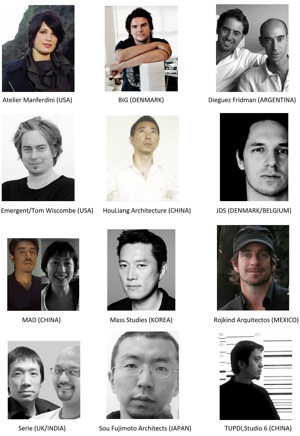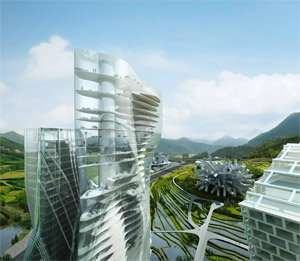
I realize these speculative visionary proposals can be a little hard to swallow while the economy continues to drill a hole into the center of the earth, but there are some really beautiful formal investigations in MAD's Huaxi City proposals, so we're going to serve them up. Pretend it's the good old days (remember mid-2008?) when anything imagined can be matched up with an equally ambitious, and fully financed, developer.
In 2008, MAD organized and invited 11 young international architects to carry out an urban experiment: to design the Huaxi city centre of Guiyang, in South Western China. The architects invited by MAD included: Atelier Manferdini (USA), BIG (DENMARK), Dieguez Fridman (ARGENTINA), EMERGENT/Tom Wiscombe (USA), HouLiang Architecture (CHINA), JDS (DENMARK/BELGIUM), MAD (CHINA), Mass Studies (KOREA), Rojkind Arquitectos (MEXICO), Serie (UK/INDIA), Sou Fujimoto Architects (JAPAN). The masterplan was developed by Shanghai Tongji Urban Planning and Design Institute, Studio 6, together with MAD.


In the past 15 years, around 10 billion
sqm of built space has been created in
the urban areas of China. In 20 years
time, another 200 to 400 new cities will
be built. Until now, the results of this
overwhelming urbanization have been
defined by high-density, high-speed and
low-quality duplication: the urban space
is meaningless, crowded and soulless.
Are we going to continue copying the
skyline of Western cities created over a
hundred years of industrial
civilisation? Will Manhattan and Chicago
continue to be our model city, even
after 15 years of urban construction in
China?
Is there an alternative future for our
cities that lies in the current social
condition, where new technologies leave
the machine age behind, and where the
city increasingly invades the natural
space? Based on an Eastern understanding
of nature, this joint urban experiment
aims to explore whether we can use new
technologies and global ideas to
reconnect the natural and man-made
world.
The site of Huaxi is famous for its
dramatic and beautiful landscape, as
well as a diverse mix of minority
cultural inhabitants during its history.
Its future is defined by the local
government’s urban planning as a new
urban centre for finance, cultural
activities and tourism. MAD brought the
young architects together here in the
summer of 2008, for a 3-day workshop to
create an experimental urban vision for
Huaxi.
Each architect provided a unique design
for a single part of the masterplan,
based on their own understanding and
interpretation of the local natural and
cultural elements. The result is a
series of organic individual buildings,
growing from the natural environment,
and working together to produce a
compound of diverse urban activities.
In this high density urban environment,
the limits of urbanization are
controlled and set by nature; the
buildings take on the dynamic topography
of the site, touching the landscape in a
more interactive way. Generic
verticality is replaced by a complex
taxonomy of urban activities, defined by
a multiplicity of connections, detours
and short cuts. The natural and the
artificial are fused together, revealing
an image of a future architecture.
The ecological method here is not just
focused on saving energy; rather, the
goal is to create a new, balanced urban
atmosphere which can evoke the feeling
of exploring the natural environment.
The city is no longer determined by the
leftover logic of the industrial
revolution (speed, profit, efficiency)
but instead follows the ‘fragile rules’
of nature. This collaborative experiment
thus provides an alternative, responsive
model for the development of the urban
centre: a man-made symbiosis, in harmony
with nature, in which people are free to
develop their own independent urban
experience.
China has become the global laboratory
for urbanization, where the logical
endpoint of current architectural trends
can be seen, and the effects of leaving
private developers to create cities can
be most keenly felt. This urban
experiment is not intended as an
idealized urban reality, but as an
attempt to push these trends to their
purest forms, with all of the benefits
and problems that this brings. MAD is
aware of, and actively encouraging, the
failings and successes of this project.
21 Comments
Keep the dream alive.
This project is so horrifying I don't even know where to begin. I am glad for the current economy when I see monstrosities like this because I know they won't get built. I'm making note of every firm involved, in insure that I never apply to work for them in the future.
bereft...
the vision displayed here is simplistic, naive, and horrifying all at the same time....as it was in 2008, 07, 06, 05.....
"Is there an alternative future for our cities that lies in the current social condition" well i hope this is not it. "and where the city increasingly invades the natural space? " isn't this suburban sprawl...is this not the reason for the mess we are in right now? "but instead follows the ‘fragile rules’ of nature." Really...i have never seen a highway with surrounded by skyscrapers in Yellowstone. That statement just screams bullshit. have we learned anything? it seems like a re hashing of the disastrous failure of corbu's "le plan' for pairs all over again.
When you build like this, what you get is essentially an edge city office park, no matter how hard you try to do something else.
i fail to see how this is so horrifying as to rant about it. lets get over ourselves
if you choose to not work for this many firms based on one speculative and clearly theoretical project, that is a little ridiculous and you are narrowing yourself
unless you are actually learning what these firms do, to actually make an informed decision beyond your "will not work for X" list, but that isnt how it sounded
Well, let's rephrase in a more nuanced way then. If this conceptual work is representative of the overall tenor of the work that these firms do, then count me out.
send them some emails and let them know
I'm curious about the concealed motive here. This is about publicity, right? They're getting the attention of the government and developers. Once they're hired, they will care about local poverty, energy consumption, sprawl, right? The architects are the good guys after all--they're just being cleverly subversive, right? At that moment when the cameras are on and the chinese people are listening carefully, the visionary non-chinese architect, risking everything, will speak about human rights and not architectural form, right?
well, that is an interesting question. ethically, can an architect work in China without being hypocritical for all those reasons you stated?
is it the job of the architect to solve those problems, or do we stay out of china altogether in a protest?
i would think there is some middle ground, but maybe not?
This is just STUPID. A stupid proposal and even more stupiderer proposals. And its not the forms that are the issue - its the scale. Its all a bunch of shit sitting on top of rice paddies. Lame.
send each of the architects involved a personal email or letter explaining how you feel, because i doubt they will be reading this webpage
That tilty tower thing is awesome!
The cool part about alot of the rants is the fact that alot of the projects try to engage with alot of issues. Just because the projects look and feel "glossy" does not mean they are souless. I know two of the projects very well(from publications) and can attest to the fact that they delve into some very interesting climate and planning strategies, and used this "theoretical" base as an attempt to demonstrate these ideas un inhibited by the realities of construction. I think as the economy tumbles, we should try to see the good in things and be supportive. I am a fan of intellectual criticism but sometimes we should be careful not to dismiss everything. Thanks to Paul for posting a great article on architects being proactive in the mass urbanization that China is undertaking_we should be part of the discussion.
Finally, architecture becomes its own caricature.
Ecological problem is the important problem of China,like other countries,But the building concept is changing,What kind of architecture can on behalf of the China,wo are thinking....
the project is beautiful and visionary, but the above commenters reveal something about our new zeitgeist:
while good ideas are easy to come by, competent implementation will earn you respect.
if each building is going to have circulations and programs, which are attractive and inviting to non-residents, the experimentation with individuatlistic forms seem interesting to me in spite of the danger of being read as a stylistic battleground, partly because it could be quite uninspiring otherwise. however, from the renderings, connections among the units are more or less visual in nature, and the urban morphology does not seem too different from what have been developed with their problems or priviledges depending on how you look at it. i would like to inquire if there were strategies involved in the planning process to make this micro city more vibrant or if cultures of virtually networked generations with their concerns for safety and exclusivity were recognized as a fact because i am a bit skeptical about the notion, 'a man-made symbiosis, in harmony with nature, in which people are free to develop their own independent urban experience' in this context.
I think this is the end of an era or a dark period before reborn. This firm are young and born with the short new economy era. The result are redundant and I do not think there is any "theoretical project" behind but just as usual the same "mega", "hyper" and "super", the same slogan or commercial indeed.
What is emerging is the category of the "monstrous" in aestechic term and the aestetic problem is the main problem for the architect because it incorporates the ethic problem. Architectureis the most public art and architect needs to serve it. If you design an ugly building or worse public space you fall double: aestetically and ethically!
Is a period where schools should re-think their architecture program and instead to pursuing to much on CAD courses they would introduce more philosophy and aesthetic courses.
walter
whats really funny is most of the kids in this post would happily have worked for such architects doing 'cutting edge' designs, but now everyone is in a 'recession' state of mind. ridiculous.
All it needs is a giant sandbox and some 50-foot infants.
Cool shapes.
Trendy work at its best without substance.
Block this user
Are you sure you want to block this user and hide all related comments throughout the site?
Archinect
This is your first comment on Archinect. Your comment will be visible once approved.